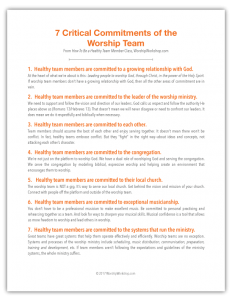Part 1 of this post looked at the first four ways we engage. (Click to read Part 1) Each of those facets of engagement had to do with others: God, leaders, other team members, and the congregation. But now we’re looking at three other ways team members engage.
5. Engage With The Local Church
So what’s the difference between engaging with the congregation and engaging with the church? Great question!
Engaging the congregation is about connecting while on the platform. Engaging with the church is about being committed and bought in to the vision of the local body of Christ.
Serving on the worship team is NOT a “gig.”
Team members need to be committed to the vision and ministry of the church. The two definitions of engaged that fit best here are these:
To bind, as by pledge, promise, contract, or oath.
To become interlocked.
A team member should have both a covenant-type commitment to the local church AND have a sense of being part of it—intertwined with other believers of your local body.
So what does “engaged with the church” look like? It means they are “all in.” This is their church home, and they are connected with it and appropriately submitted to the authority of the leadership.
It doesn’t mean that they will never disagree with leadership or church policy. But it does mean that they won’t use that disagreement to stir up dissension and disunity.
Being a fully engaged worship team member also means being a fully committed part of the local church.
6. Engage With The Music
Music is our medium. It’s one of our primary tools to both worship God and help others to worship God, so we need an understanding of how the worship team engages with music, and what the downside is.
There are a few definitions that help us grasp the idea of engagement with the music.
To occupy oneself; become involved
I’m a complete dolt when it comes to doing most anything mechanical or carpentry-related. So when I pick up a power tool, I’m timid and clumsy. A circular saw in my hand is not natural (nor is it safe for me and anyone nearby). But if you watch a gifted carpenter pick up that same saw, it’s like watching a professional quarterback drop back for a pass, or an Olympic swimmer making flip turns.
The circular saw in the hand of a carpenter is a natural extension of himself. Why? Because he’s occupied himself with that tool over and over.
As musicians and worship techs, we need to have a level of skill with our instruments that translates into effortless music. When we aren’t preoccupied with the mechanics of the song, we are free to worship and focus on the other elements of leading worship.
Another definition of “engage” that’s in play here is this:
To attract and hold fast.
As musicians, there is a real sense that the music engages us. We are attracted to it and held by it. You can tell the difference between a person executing the mechanics of a song correctly and a musician who’s IN the music. She’s feeling it. There’s an emotional connection.
And because she’s emotionally engaged, her music will help stir the emotions of those listening.
Don’t get me wrong, leading worship isn’t about eliciting an emotional response from the congregation. But good music evokes emotion. And the last time I checked, worshiping God requires heart, soul, mind and strength.
So I’m pretty sure emotions are wrapped up in there somewhere between the heart, soul, and mind.
And yes: we do want to avoid being so caught up in the music that we lose sight of the Object and Subject of our worship. But a mechanical, or clumsy, or unfeeling execution of a song is equally detrimental to worship.
The final way team members engage is this:
7. Engage With The Process
What do I mean by that? Every great team has systems and processes to make it efficient and effective. An NFL team will never see the Super Bowl without its team members fully committing to a system of practices, workouts, and plays.
A system is simply the way you or your organization gets things done. A worship team has dozens of systems for getting things done: scheduling, music planning, chart & mp3 distribution, communication, rehearsals, new musician qualification, etc..
It’s important to note that our methods to get things done don’t have to be intentional or healthy to be a system. I used to have what I refer to now as a “Four-Chord Pulse Check” system for qualifying new musicians: If the guy could play four chords and had a pulse, he was on the team.
Healthy? No.
Intentional? Not a chance.
A system? Yep.
So we want to make sure we have healthy and effective systems. But a system is only as good as people’s commitment to it. Which brings us to these two definitions of engage:
To assume an obligation.
As part of the condition of serving in the worship ministry, team members have an obligation to the systems that make the ministry effective. For instance, my team is required to confirm their scheduled times in our worship planning application. That same policy requires them to find their replacement if they cannot make a scheduled time (and didn’t block out their dates ahead of time).
This policy creates an effective system that helps the team member own the scheduling process. AND it keeps me from chasing down substitutes and scrambling to cover last-minute call-offs.
There’s another definition of engagement at work here with systems:
To become interlocked.
Healthy, intentional and productive systems help to interlock team members. The above-mentioned system of scheduling requires team members to depend on each other, rather than let everything default to the leader.
Here’s another example: a healthy system of preparation will require and encourage personal practice and effective rehearsals. Practice and rehearsal are tools for helping team members engage with one another, with their leaders, and the congregation.
And really, great preparation allows them to engage with God more deeply, too.
Wrapping Up
A healthy worship team requires engagement on so many levels. Here the various ways again, so you don’t have to go back to the last post:
Engaged with God
Engaged with leaders
Engaged with other team members
Engaged with the congregation
Engaged with the congregation
Engaged with the music
Engaged with the systems
Take some time to consider how engaged your team is in each area.
 Get a free “Cheat Sheet” with all seven engagement areas. You can share it with your team and use it for discussion.
Get a free “Cheat Sheet” with all seven engagement areas. You can share it with your team and use it for discussion.
[Get Access Here]
In the comment section below, let us know which aspects of engagement your team needs to work on. And how could you challenge them to a deeper level of engagement?
Stuck?
Learn how to level-up your team with this free video training.







